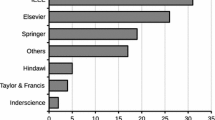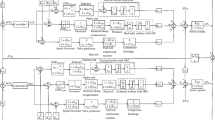Abstract
This paper presents an efficient and reliable evolutionary-based approach to solve the optimal power flow (OPF) problem. The proposed approach employs differential evolution algorithm for optimal settings of OPF problem control variables. The proposed approach is examined and tested on the standard IEEE 30-bus test system with different objectives that reflect fuel cost minimization, voltage profile improvement, and voltage stability enhancement. The proposed approach results are compared with the results reported in the literature. The results show the effectiveness and robustness of the proposed approach.
Similar content being viewed by others
References
Alsac O, Stott B (1974) Optimal load flow with steady state security. IEEE Trans Power Apparatus Syst 93: 745–751
Dommel H, Tinny W (1968) Optimal power flow solution. IEEE Trans Power Apparatus Syst PSA-87(10): 1866–1876
Shoults R, Sun D (1982) Optimal power flow based on P–Q decomposition. IEEE Trans Power Apparatus Syst PSA-101(2): 397–405
Happ HH (1977) Optimal power dispatch: a comprehensive survey. IEEE Trans Power Apparatus Syst PSA-96: 841–854
Mamandur KRC (1981) Optimal control of reactive power flow for improvements in voltage profiles and for real power loss minimization. IEEE Trans Power Apparatus Syst PSA-100(7): 3185–3193
Habiabollahzadeh H, Luo GX, Semlyen A (1989) Hydrothermal optimal power flow based on a combined linear and non-linear programming methodology. IEEE Trans Power Apparatus Syst PWRS-4(2): 530–537
Burchett RC, Happ HH, Vierath DR (1984) Quadratically convergent optimal power flow. IEEE Trans Power Apparatus Syst PAS-103: 3267–3276
Aoki K, Nishikori A, Yokoyama RT (1987) Constrained load flow using recursive quadratic programming. IEEE Trans Power Apparatus Syst PAS-2(1): 8–16
Reid GF, Hasdorf L (1973) Economic dispatch using quadratic programming. IEEE Trans Power Apparatus Syst PAS-92: 2015–2023
Stadlin W, Fletcher D (1982) Voltage verus reactive current model for dispatch and control. IEEE Trans Power Apparatus Syst PAS-101(10): 3751–3758
Mota-Palomino R (1986) Sparse reactive power scheduling by a penalty-function linear programming technique. IEEE Trans Power Apparatus Syst PAS-1(3): 31–39
Abou El-Ela AA, Abido MA (1992) Optimal operation strategy for reactive power control. Modeling, simulation and control, Part A, vol 41(3). AMSE Press, New York, pp 19–40
Sun DI, Ashley B, Brewer B, Hughes A, Tinney WF (1984) Optimal power flow by newton approach. IEEE Trans Power Apparatus Syst PAS-103(10): 2864–2880
Santos A (1995) Optimal power flow solution by Newton’s method applied to AN augmented lagrangian function. IEE Proc Gener Transm Distrib 142(1): 33–36
Rahli M (1999) Optimal power flow using sequential unconstrained minimization technique (SUMT) method under power transmission losses minimization. Electr Power Syst Res 52: 61–64
Momoh JA (1999) Improved interior point method for OPF problems. IEEE Trans Power Apparatus Syst 14(3): 1114–1120
Momoh JA, El-Hawary ME, Adapa R (1999) A review of selected optimal power flow literature to 1993. Part I: Non-linear and quadratic programming approaches. IEEE Trans Power Syst 14(1): 96–104
Momoh JA, El-Hawary ME, Adapa R (1999) A review of selected optimal power flow literature. Part II: Newton, linear programming and interior point methods. IEEE Trans Power Syst 14(1): 105–111
Lai LL, MA JT, Yokohoma R, Zhao M (1997) Improved genetic algorithm for optimal power flow under both normal and contingent operation states. Electr Power Energy Syst 19: 287–291
Osman MS, Abo-Sinna MA (2003) A solution to the optimal power flow using genetic algorithm. Elsevier, Amsterdam
Miranda V, Srinivasan D, Proenca LM (1998) Evolutionary computation in power systems. Electr Power Energy Syst 20: 89–98
Abido MA (2002) Optimal power flow using tabu search algorithm. Electr Power Compon Syst 30(5): 469–483
Abido MA (2002) Optimal power flow using particle swarm optimization. Int J Electr Power Energy Syst 24(7): 563–571
Feoktistov V (2006) Differential evolution in search of solutions. Springer, Berlin
Das S, Abraham A, Konar A (2008) Particle swarm optimization and differential evolution algorithms: technical analysis, applications and hybridization perspectives. Appl Soft Comput J 7(3):1019–1026. Availlable at: www.softcomputing.net/aciis.pdf
Karaboga D, Okdem S (2004) A simple and global optimization algorithm for engineering problems: differential evolution algorithm. Turk J Electr Eng 12(1): 53–60
Storn R (1997) Differential evolution, a simple and efficient heuristic strategy for global optimization over continuous spaces. J Glob Optim 1: 341–359
Thomas P, Vernon D (1997) Image registration by differential evolution. In: Proceedings of the Irish machine vision and image processing conference, pp 221–225
Storn R (1996) Differential evolution design of an IIR-filter with requirements of magnitude and group delay. In: Proceedings of the IEEE conference on evolutionary computation, pp 268-273
Storn R (1999) System design by constraint adaptation and differential evolution. IEEE Trans Evol Comput 3(1): 22–34
Liu J, Lampinen J (2002) A fuzzy adaptive differential evolution algorithm. Lappeenranta University of Technology, TENCON ‘02 Proceedings 2002 IEEE Region 10 conference on computers, communications, control and power engineering, vol 1, pp 606–611
Lee K, Park Y, Ortiz J (1985) A united approach to optimal real and reactive power dispatch. IEEE Trans Power Apparatus Syst 104(5): 1147–1153
Abido MA (2006) Multiobjective optimal VAR dispatch using strength pareto evolutionary algorithm. In: IEEE Congress on Evolutionary Computation Sheraton Vancouver Wall Centre Hotel, Vancouver, BC, Canada, 16–21 July
Dieu VN, Ongsakul W (2006) Enhanced augmented Lagrange Hopfield network for economic dispatch with piecewise quadratic cost functions. In: IEE proceedings on generation. Transmission and distribution, April
Author information
Authors and Affiliations
Corresponding author
Rights and permissions
About this article
Cite this article
Abou El Ela, A.A., Abido, M.A. & Spea, S.R. Optimal power flow using differential evolution algorithm. Electr Eng 91, 69–78 (2009). https://doi.org/10.1007/s00202-009-0116-z
Received:
Accepted:
Published:
Issue Date:
DOI: https://doi.org/10.1007/s00202-009-0116-z




